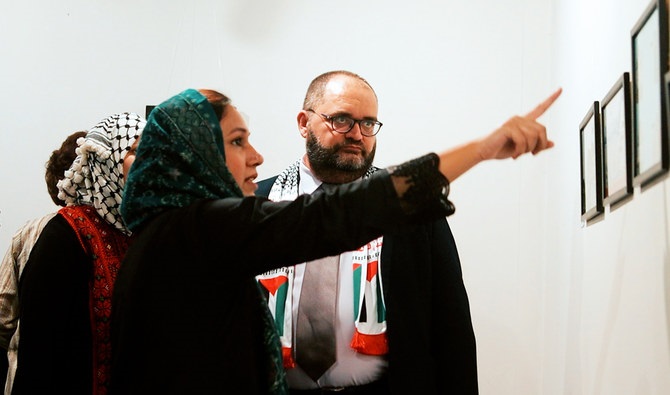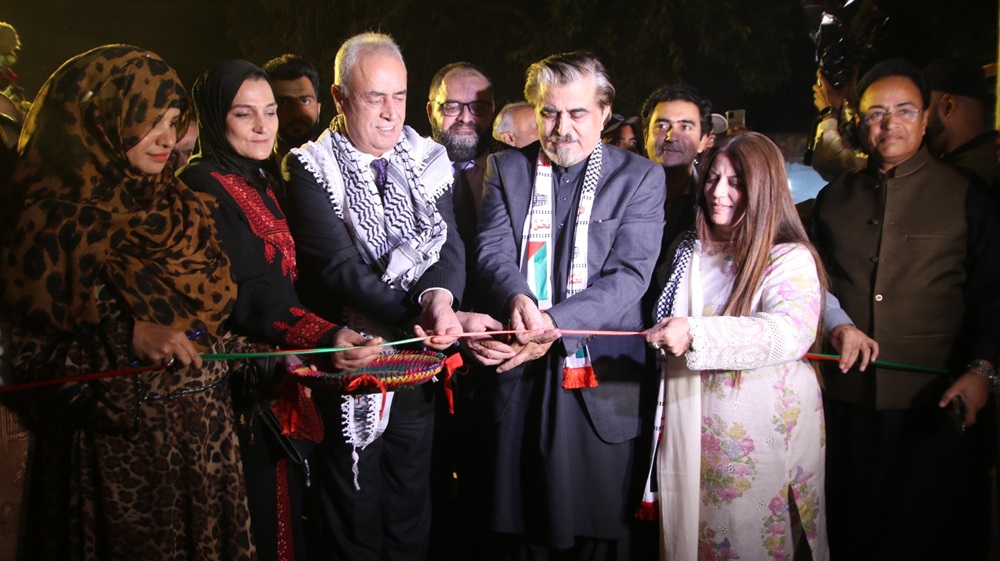
Written by: Ayesha Amir
Posted on: November 14, 2023 |  | 中文
| 中文
A painting from the exhibition 'In the Pursuit of Freedom'
Art has always been employed as a powerful tool of resistance and a form of expression in various ways across different historical and sociopolitical contexts. Historically, visual art, such as paintings, sculptures and graffiti, have helped in conveying powerful political messages. Graffiti, in particular, has been used to express dissent and resistance in public spaces. Similarly, street art and murals often serve as a visual representation of resistance movements, depicting their goals, struggles and aspirations. Symbols and icons, such as flags, images, and logos, can become potent symbols of resistance and solidarity.
Given this unique ability of art to evoke emotions, challenge normative perceptions and reach a diverse audience, makes art an essential form of resistance. It allows individuals and communities to express their grievances, assert their identity and demand change, often transcending language and cultural barriers to connect with people on a deeper and emotional level. Art's impact as a tool of resistance is evident in countless social and political movements worldwide, including the Palestinian force for resistance. To show solidarity with Palestinian victims of Israeli violence, an art exhibition was held at Lok Virsa, Islamabad. Very aptly so, the name of this exhibition was “In Pursuit of Freedom”. This exhibition was primarily a fundraiser in solidarity with the people of Palestine, and the participating artists will be donating 50 percent of the proceeds from this exhibition to the people of Gaza. Israel’s unrestrained bombing has killed over 4,000 children and 10,000 people in total, and still there is no sign of ceasefire.

Nader AlTurk, deputy head of the Palestine Mission in Pakistan (right) and the curator of the show, Sundas Azfer, at the exhibition
Nader AlTurk, deputy head of the Palestinian Mission in Pakistan, also attended the exhibition and thanked Lok Virsa for organizing the exhibition in support of the Palestinian cause. He said that pictures, paintings and art pieces give a strong message, and exhibitions like this will help in raising awareness about the plight of the Palestinian people. According to the curator of the show, Sundas Azfer, some of the artists have agreed to donate the entirety of their proceeds for this noble cause. The Palestine Pavilion at the Lok Virsa, also had children engaging in creative pursuits, and all the earnings from their work will be donated for relief work in Palestine. Federal Minister for National Heritage and Culture, Jamal Shah, and the Ambassador of Palestine to Pakistan, Ahmed Amin, inaugurated the exhibition and visited the Palestine Pavilion at Lok Virsa.

H.E. Ahmed Amin, Ambassador of Palestine to Pakistan, and Federal Minister for Culture and Heritage, Jamal Shah, opening the exhibition
Not only did the exhibit showcase masterful work from Pakistani artists, but it also featured the works of artists from Lebanon and Bahrain. In a diverse array of artists, the participating names included Javeria Ahmed, Haris Qayyum, Rabia Aijaz, Alefiya Abbas Ali, Nabahat Amin, Minna Haroon, Sundas Shaukat, Sundas Azfer, Sara Qaed, Javeria Ali, Uzma Farooqi, Faziel Shah, Hanane Kai and lastly, Sakina Akber. Various Palestinian and Pakistani dignitaries graced the occasion, and talked about the importance and impact of Lok Virsa taking this initiative; it represents the Pakistani community as a whole, who stand one with the Palestinians.
Exhibitions of this kind aid in bringing attention to social and political issues that need to be addressed. Artists often use their work to shine a light on the injustices, oppression and the denial of rights, making these problems more visible to the public. This increased awareness can lead to greater support for movements aimed at securing freedom and justice. Art serves as a historical record of the struggle for freedom because artists document the events and experiences of their time, through sculpted or painted mediums. This was visible in the Lok Virsa exhibit also, which showcased beautiful pieces of self-expression where artists had presented their own rendition and understanding of the injustices. Some examples include the portrait of a lady who had proudly dyed her hair in the colors of the Palestinian flag, while another sculpture of a half-destroyed building turned into rubble, with protruding rebars drove home the harrowing reality of the destruction in Gaza.
We as a community are in a process of collective grieving for the atrocities our brothers and sisters are suffering in Gaza. In times like these, art, among other things, can serve as a means of healing and catharsis, and also for expressing solidarity. It gives us a voice and a means for processing our own emotions, find solace and regain a sense of agency. It is imperative for us all to use what is at our disposal, whether big or small, to be the voice for Palestine.
You may also like: